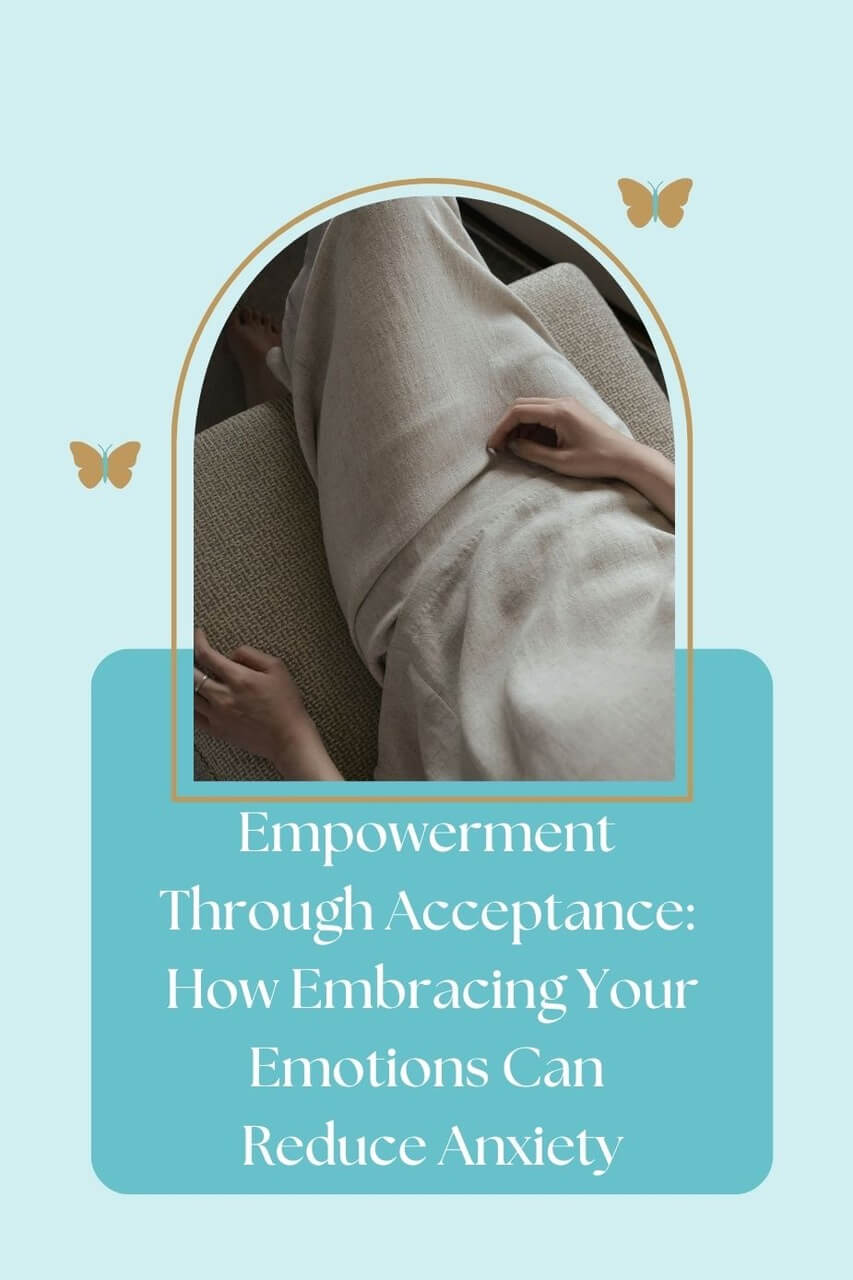Anxiety can often feel like an unwelcome guest, barging in unannounced and making it hard to find peace. Many people want to push anxiety away or fight against it. But what if, instead, we welcomed anxiety as a part of our human experience and learned how to navigate it with grace and acceptance? This blog explores how holistic anxiety therapy can help transform anxiety from a source of chaos into an opportunity for calm, clarity, and growth.
I’ll cover the importance of accepting anxiety, practical techniques to manage it, and the role of holistic anxiety therapy and somatic approaches in creating a balanced, resilient life. Let’s dive into understanding anxiety, embracing it, and learning how to live alongside it.
Understanding Anxiety: Why We Need It
Most of us see anxiety as something to avoid or eliminate, but anxiety actually serves a crucial function. It’s our body’s natural response to perceived threats, helping us stay alert and ready to take action when needed. Anxiety is like an internal alarm system, signaling to our bodies that something might require attention or caution.
However, this alarm system can sometimes become too sensitive, reacting to situations that aren’t dangerous. This overactivity is where anxiety becomes problematic, making daily life feel like a series of obstacles rather than opportunities. Instead of trying to “get rid” of anxiety, a more effective approach is to understand its purpose and learn how to live with it constructively.

The Value of Acceptance: What Does It Really Mean?
Acceptance is often misunderstood. It doesn’t mean giving up or resigning yourself to feeling anxious forever. Rather, acceptance involves recognizing that anxiety is a natural part of being human. It means acknowledging that you feel anxious without judgment or resistance and without adding extra layers of frustration or guilt.
As Jon Kabat-Zinn, a pioneer in mindfulness practice, states: acceptance is an active process. It takes strength and patience to acknowledge your reality and then decide to respond to it in a way that aligns with your values and goals. Acceptance doesn’t mean liking anxiety; it means choosing to face it head-on rather than turning away.
Why Focus on Acceptance Instead of Eliminating Anxiety?
Many people focus on getting rid of anxiety altogether, but this is not only unrealistic—it can actually make anxiety worse. When we resist anxiety, we often engage in behaviors like avoidance or suppression, which might offer short-term relief but lead to more anxiety over time.
Imagine trying to avoid every situation that makes you anxious. You might feel better for a moment, but in the long run, you miss out on important experiences, like building relationships, pursuing meaningful goals, or just enjoying life. Moreover, avoiding anxiety can actually make it stronger because it reinforces the idea that the situation is dangerous, even when it isn’t.
Similarly, trying to suppress anxious thoughts often makes them more persistent. If you tell yourself not to think about a pink elephant, what happens? You probably think about a pink elephant. The same is true with anxious thoughts—the more you try not to think about them, the more they persist.
Misconceptions About Acceptance
Many people believe that acceptance means giving up or surrendering to anxiety. They fear that accepting their anxious thoughts will make them more overwhelming or even encourage them to continue. In reality, acceptance is not about giving up but about giving yourself permission to feel your emotions without letting them control your actions. It is the first step toward managing anxiety by reducing the emotional resistance that often intensifies stress.
What is Radical Acceptance?
Radical acceptance takes the concept of acceptance even further. It’s the practice of fully accepting your present reality, no matter how uncomfortable or challenging it may be. It doesn’t mean you approve of the situation, but you stop fighting against it. For example, if you are feeling anxious about a new job, radical acceptance might involve recognizing that you are scared and that it’s okay to feel that way.
By embracing what is, rather than getting caught up in “what ifs” or “should haves,” radical acceptance allows us to break free from cycles of worry and regret. It can be a powerful tool for transforming anxiety from something that feels unbearable into something manageable.
Example of Radical Acceptance in Practice
Imagine someone who experiences intense anxiety before social gatherings. Radical acceptance would involve recognizing the fear and discomfort without trying to suppress it or force it away. Instead of saying, “I shouldn’t feel this way,” they might say, “I feel nervous about being around new people, and that’s okay.” This acknowledgment can reduce the anxiety itself by removing the extra layer of judgment that often makes it worse.
Strategies for Embracing Anxiety
Here are some practical steps, in addition to anxiety therapy, to help you start accepting and working with your anxiety, rather than against it:
1. Focus on Sensations, Not Thoughts
When anxiety hits, it’s easy to get caught up in your racing thoughts. Instead, try shifting your attention to the physical sensations in your body. Notice what you feel—like a tightness in your chest or tension in your shoulders. Rather than labeling these sensations as “bad,” get curious about them. What color or shape would you give them? How do they change as you focus on them without judgment? By staying with the sensation itself, you may find it begins to change or lessen.
2. Create a Name or Image for Your Anxious Thoughts
It can be helpful to personify your anxiety. Give it a name, like “Worry Monster” or “Anxious Mind.” When anxious thoughts come up, try saying, “Oh, Anxious Mind is here again.” You could also imagine your anxiety as an image—maybe a storm cloud or a buzzing bee. This practice helps you acknowledge the anxiety without being overwhelmed by it, creating a sense of separation from your anxious thoughts.
3. Respond to Anxiety with Compassion
Instead of criticizing yourself for feeling anxious, try to be kind to yourself. Reframe your self-talk with compassion. Instead of thinking, “Why is this happening to me?” try saying, “It’s okay to feel anxious right now. I’m doing the best I can.” This approach helps you accept your feelings without adding extra layers of guilt or frustration.
4. Find Soothing Activities That Work for You
While acceptance doesn’t mean that anxiety will feel good, you can find ways to comfort yourself when it arises. Engage your senses to find what brings you calm. Maybe it’s listening to soft music, drinking a warm cup of tea, or taking a few deep breaths with a calming scent nearby. Experiment with different activities to discover what helps soothe your anxiety.
5. Use Grounding Techniques to Stay in the Moment
When anxiety strikes, it often pulls you out of the present. Grounding techniques can help you reconnect with the here and now. Start by focusing on your breath—breathe in for four seconds, hold for four, then breathe out for six. Next, try the 5-4-3-2-1 technique: identify five things you can see, four you can touch, three you hear, two you can smell, and one you can taste. These exercises help remind your body that you are safe in the present moment.
6. Journal to Explore Your Feelings
Writing can be a powerful way to process anxiety. Try visualizing your anxiety as a part of yourself and engage with it in a curious and compassionate way. Ask, “What are you trying to tell me?” or “What do you need right now?” You might find comfort in placing your hand over your heart and reminding yourself that it’s okay to feel anxious and that you are here to support yourself through it.

Somatic Techniques to Promote Acceptance
Somatic therapy focuses on the connection between the mind and body. It encourages awareness of physical sensations as a way to process emotions and reduce anxiety. Somatic methods include mindfulness practices, breathing exercises, and body scanning to help individuals feel grounded in their bodies and better understand their feelings.
Mindfulness-Based Stress Reduction
Mindfulness involves paying attention to the present moment without judgment. For someone dealing with anxiety, mindfulness can be a powerful way to recognize anxious thoughts without becoming overwhelmed by them. Techniques such as mindful breathing or body scanning can help ground a person in the here and now, creating a sense of calm and acceptance.
Example: Mindful Breathing for Anxiety
Imagine you are feeling anxious about an upcoming event. A mindful breathing exercise could involve taking a deep breath in through your nose for a count of four, holding it for four, and then slowly exhaling through your mouth for four. As you breathe, notice the sensations in your body—your chest rising and falling, the feel of the air entering your lungs. This practice helps redirect your focus from anxious thoughts to your physical sensations, allowing you to accept the anxiety without becoming entangled in it.
Holistic Approaches to Acceptance and Anxiety
Holistic anxiety therapy views anxiety not just as a mental or emotional experience but as one that affects the whole person—mind, body, and spirit. To truly address anxiety, holistic methods emphasize healing from all angles. This might involve anxiety therapists using talk therapy, body-based practices, lifestyle changes, and spiritual exploration.
Combining Cognitive and Somatic Approaches
A balanced anxiety therapy approach often combines cognitive techniques, like Cognitive Behavioral Therapy (CBT), with somatic practices. For example, someone might use CBT to challenge irrational thoughts (“I must perform perfectly or I will fail”) while simultaneously engaging in yoga or breathwork to calm the body’s stress response. Together, these practices help create a well-rounded strategy for accepting and managing anxiety.
Recognizing Anxiety to Transform It
To begin transforming anxiety, it’s essential to first recognize it. Pay attention to the signs—racing thoughts, muscle tension, a tight chest, or shallow breathing. Acknowledging these symptoms is a form of acceptance. Instead of trying to push them away, ask yourself, “What is my anxiety trying to tell me?” Is it a fear of the unknown? An unmet need? Understanding the root of your anxiety allows you to address it more effectively.
Developing Emotional Agility and Resilience
Emotional agility involves staying flexible with your thoughts and feelings, allowing you to adapt and respond to anxiety with resilience. It’s about understanding that anxiety is just one of many emotions and learning how to move through it rather than getting stuck. Distress tolerance skills, such as self-soothing and grounding, help manage anxiety without feeling overwhelmed, supporting long-term emotional health.
Practicing Emotional Agility
Practicing emotional agility helps build resilience. Emotional agility is the ability to navigate your feelings in a way that doesn’t derail you. It means accepting all emotions, even difficult ones, without letting them take over. When you accept your feelings, you can respond to them thoughtfully, rather than react impulsively.
Example: Emotional Agility in Daily Life
Imagine you are facing criticism at work, which triggers feelings of anxiety. Instead of reacting defensively, emotional agility involves taking a moment to breathe, acknowledging your feelings of discomfort, and choosing a response that aligns with your values—perhaps calmly discussing the feedback or seeking clarification.
Understanding and Practicing Distress Tolerance
Distress tolerance is the ability to endure emotional pain and stress without trying to escape it immediately. It’s an important skill in managing anxiety because it teaches us how to cope with difficult emotions without letting them control us. Techniques like grounding exercises or self-soothing can help build this tolerance over time.
Example of Distress Tolerance in Action
If you feel overwhelmed by anxiety, a distress tolerance technique might involve grounding yourself by focusing on your surroundings—what can you see, hear, or feel? This shifts your focus away from the overwhelming emotion and onto something tangible, helping you to ride out the feeling without panicking.
Moving from Coping to Thriving
Acceptance is the key to transforming anxiety. By learning to accept and coexist with our emotions, we reduce the power they have over us. This does not mean that anxiety will disappear, but that we learn how to live with it in a way that allows us to thrive. From radical acceptance to mindfulness and somatic practices, the goal is to create a toolkit of strategies that help you manage anxiety and build a more balanced, fulfilling life.
Finding Your Balance Among Stressors
If you find yourself struggling with anxiety and seeking ways to embrace your emotions and build a path toward calm, consider reaching out for support. At Marilyn Ashley, LMFT, we offer a range of holistic and somatic techniques tailored to help you find your balance. Let’s work together to turn anxiety from a barrier into a bridge toward your most empowered self. Reach out today to begin your journey toward acceptance and inner peace.

Heal From Your Anxiety With Anxiety Therapy in Manhattan Beach, CA
Ready to turn anxiety into a stepping stone rather than a stumbling block? At Marilyn Ashley, LMFT, we specialize in holistic anxiety therapy that helps you embrace your emotions and navigate them with grace. Take the first step toward a more balanced and resilient life, let’s embark on this transformative journey together. Follow these three simple steps to get started:
- Schedule Your 20-Minute Complimentary Phone Consultation
- Learn More About Me and My Services
- Start embracing your emotions and healing from your anxiety!
Additional Services Offered By Marilyn Ashley, LMFT
At my Hermosa Beach, CA practice, holistic Anxiety Therapy is just one of the services I offer to help you embrace your emotions and heal from your anxiety symptoms. In addition to helping you cope with anxiety, I specialize in Life Transitions, Trauma, and Couples Therapy. At my Hermosa Beach, CA Practice, I work with adult clients from Manhattan Beach, Redondo, Beach, El Segundo, and the rest of the South Bay area, and we work toward embracing your anxiety and using it as a tool for growth and transformation. I also offer online therapy sessions for those located anywhere else in California. By incorporating holistic practices into your daily life, you can support your overall well-being. I’m excited to work with you on your journey towards healing and growth. Together, let’s embrace your anxiety and learn how to thrive, not just survive! Check out my blog for more about holistic healing!

Hi there!! I’m Marilyn. I empower individuals to embrace their true selves, heal holistically and flourish. I provide in-person therapy in Hermosa Beach, California and the greater South Bay area as well as online therapy throughout California, Colorado, Florida, Kansas and South Carolina. Click here to get started.

